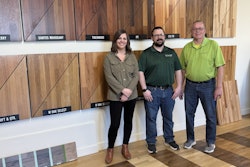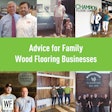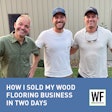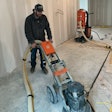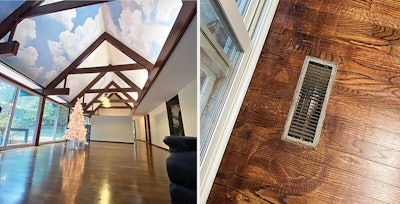
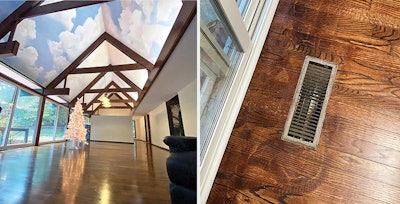 Most people don't understand why you are more expensive, so you have to teach them what paying more will mean for them. These are "before" photos from a job we recently refinished—it looks fine in the room scene, but when I walked the floor, I saw the sanding was horrific.
Most people don't understand why you are more expensive, so you have to teach them what paying more will mean for them. These are "before" photos from a job we recently refinished—it looks fine in the room scene, but when I walked the floor, I saw the sanding was horrific.
Back when I first started my company, if I was on a job and got a call from someone interested in getting a wood floor, I'd be like, "Cool, I'll leave the job right now to come over and measure it." That resulted in a lot of me running around like a lunatic. It's been many years since those times, and today my process is a lot different in how I handle customers from the first contact. Here are some of the things I've learned to do to save time and make more money in my estimating process.
1) I screen out tire kickers on the phone.
Today, to tell if people are serious when they call, I ask them if they wouldn't mind taking some pictures of the space and sending them to me with examples of the colors they had in mind. I've had people say, "Sure, I'll do that" and then they never do—but the people who take the time to do it are serious. This has helped me tremendously. I know that some pros actually ask the customers to take photos and do all the measurements and then give an estimate based on that, but I don't think that would work for me.
2) I interview the clients while they interview me.
When I meet someone in person, I can tell right away when someone's price shopping versus someone who's looking for a craftsman. If people are shopping on price or want someone in and out in a hurry, I'll be open about telling them there's a prefinished product available that would work, but if they're looking for craftsmen, that's where we come into play. In the last year, we haven't done any prefinished jobs. At this point, if previous clients want to go that route, I'll refer them an interior designer I work with who can get the samples together for them.
3) I turn down jobs.
I'm going to be brutally honest; that's just how I operate. Recently I've been getting quite a few calls to sand an engineered floor, and I just explain to them that I feel more comfortable not doing it. When you're sanding engineered flooring, especially ⅜ inch, at some point you risk burning through the wear layer, and when you do, you own the floor. Another thing I won't do is attempt a recoat on a floor when I think it has wax, Mop N Glo, polish, or anything else like that on the floor. I know there are products out there that will dissolve it, and there could be good money it in, but I'm not even interested. A great thing about this trade is you can pick and choose your battles, and those are battles I don't want.
4) I have a minimum bid amount.
A huge improvement for my business is that I now have a minimum charge for any job. If someone just needs their foyer and living room refinished, going to sand their 407 square feet of flooring, even at $4/foot, can potentially cost me money. I'll be honest about that with a customer. When they ask what I mean, I explain I have to pay liability insurance, van insurance, workers comp, and the expense of my three guys going there (depending on the finish, as many as three times). Even though the majority of our work is within 20 minutes of our location, the math just doesn't work. My minimum charge is between $1,200 and $1,500. If someone doesn't want to pay it, I understand, but I can't go to a house knowing I'm going to lose money. If you're a one-man show, it's different, but if you have three guys on a job like I do, it doesn't work.
RELATED: How I Started: $37, No Car and No Connections
5) I never give a square foot price.
Someone asked me recently how much I charge per square foot, but at this point, I will not give someone that number because there are so many variables. I quote based on the floor plan layout, the floor condition, the species, the finish system, whether it's stained … every quote is tailored for that specific job site and what that customer's needs are. If you try to have a standard price, sometimes you might end up ahead, but other times you just shoot yourself in the foot.
6) I'm not afraid to be the highest bid.
If you want to bid higher but don't attempt it, you'll always end up wondering what could have been. I hear a lot of guys say they're going to try it, but they never do. We're in business to make money. Of course, you can't just give a higher price, you have to justify it. At first, most people see the money, not the value, behind the contractors, so you have to teach them. I recently posted some photos on my social media accounts of an existing floor we're going to be refinishing. I purposely posted a photo of the whole room, because from that broad view, the floor looks fine. Then I posted photos from when I walked the perimeter, because the sanding was horrific. Even someone who knows nothing about wood floors can look at that picture and see how bad it is. Just like you can buy Dollar General car wash or you can buy premium car wash, you can choose a Dollar General-caliber contractor or a true professional. I'll talk about it with customers: You walk on your floor every single day—would it be worth it to see those edger marks every day just because you got a better price? I teach them about everything that makes us different, from our dust containment equipment to the quality of finishes we use. Most people don't really frown on paying more if they understand why you're different. Speaking of which ...
7) I go over credentials.
I can't even tell you how beneficial credentials are—when you list them, telling the customer the education and certifications you have, people's jaws just drop and they get a sense of your credibility. It really helps you sell. I recently did a job where they needed tile torn out and the wood flooring seamlessly laced into the existing floor. Our quote was a couple thousand higher than the other guys in town who quoted it, but because our list of credentials was a mile long, they felt comfortable that we would do the best job.
8) I show my enthusiasm.
Your drive and passion have a lot to do with how you sell yourself, your company and your work. I love what I do, and it shows when I'm talking with potential clients. I can talk shop all day, and if they ask questions about the technical aspects of our process, like our grit sequence, I'll go into as many details as they want. I've had customers tell me the reason they went with us was, "You are so passionate about what you do—you were so excited about it!" Have faith in yourself and be confident in what you're selling, and your customers will feel the same.
RELATED: Why I Charge for Wood Floor Estimates
















